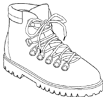Walking and Hiking Boots Gear Guide - Buying Guide

1 Material of Construction
Leather is the traditional material for construction for boots. It is water-resistant and allows your feet to 'breathe'. Periodically, you may need to wax leather boots or treat with water-resistant spray to restore the water resistance - particularly on stitched areas which may start to leak over time. The thickness of the leather will affect the feel of the boot as well as its warmth. Some boots have a waterproof lining made from Gore-Tex®, Sympatex or something similar. Whilst the lining will enhance the water-proofness, it will also make your feet hotter. Boots available in fabric materials are often lighter-weight than leather alternatives.
2 The Upper
Should be flexible enough to ensure comfort but provide protection for your toes and ankle if you plan to walk on rougher terrain. The sides of the boot should be high enough to support your ankle.
The heel 'cup' must provide support so that heel doesn't move too much over rough terrain. Internal stiffening around the heel & toe will provide protection. Check both by pressing between finger and thumb. The stiffer the boot the more suitable it will be for more rugged walking.
A good scree cuff (the padded section that surrounds the top of the ankle) and a padded tongue joined to the upper along its entire length will prevent small stones, debris and water from getting inside the boot.
3 Sole
The sole should be 'treaded' to ensure a good grip and made from a material that offers good adhesive properties - like rubber. PVC should be avoided. You should also check out the cushioning offered by the boot – generally speaking the more cushioning there is the better particularly for walking on granite (eg in the Lake District) or on tarmac. If you intend backpacking, then try the boots out wearing a fully loaded pack.
4 Flexibility
Squeeze the sides of the upper - the stiffer this is the more suitable the boot is for more challenging walking. Likewise you should consider the stiffness of the sole/midsole. You can do this by flexing the boot: firstly toe to heel (to check longitudinal flexibility) then by holding the heel still and rotating the toe (to check lateral flexibility).
The more resistance there is to bending in either case, the more suitable is the boot for walking on rocky ground, or in snow or ice with crampons.
5 Lacing
Lacing should be easy to fasten and adjust. Look out for features such as hooks and 'D' rings that help if you're trying to fasten/adjust a boot with cold hands. Some boots have 'locking' hooks that hold the laces tight on the lower part of the boot while your tighten the upper section.
6 Crampon compatibility
If you’re buying a 4 season boot for winter walking then try some suitable crampons on the boot in the shop.
7 Fit & Comfort
It may seem obvious but the best boots in the world will be little use if they are uncomfortable. The type of last used to build the boot can determine the shape and size of the boot interior. (or boot volume.) So try boots from several manufacturers to find the one that suits you best.
It’s really worthwhile spending time on this!
Fitting should be snug but not overly tight. If boots are too tight, your feet are liable to get cold. Either wear your own hiking socks or borrow some from the shop. Some ranges include women’s models that are usually slightly narrower at the heel. If that’s not the case, it’s a good idea to check out lower volume men’s boots.
As a general guide, with the laces undone move your foot in the boot so that your toes touch the front. Then check you can insert a finger at the back between your heel and the back of the boot.
Also check that when laced your foot is held firmly but not squeezed. Make sure your foot will not slide forward when going downhill. Most specialist shops have a boot ramp you can stand on to test this.
See Product Reviews and Independent Gear Tests of Walking and Hiking Boots.



















